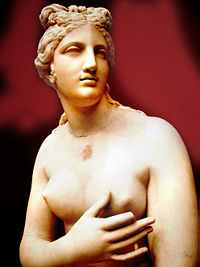Difference between revisions of "Venus (mythology)" - New World Encyclopedia
Scott Dunbar (talk | contribs) (Imported and credited article from Wikipedia, plus removed some unneeded links) |
Scott Dunbar (talk | contribs) m |
||
| Line 1: | Line 1: | ||
{{Claimed}}{{Started}} | {{Claimed}}{{Started}} | ||
| − | [[Image: Aphrodite_by_Boticelli.jpg|thumb|right | + | [[Image: Aphrodite_by_Boticelli.jpg|thumb|right|''The Birth of Venus'', (detail) by [[Sandro Botticelli]], [[1485]]]] |
[[Image:Botticelli Venus.jpg|thumb|300px|right|''[[The Birth of Venus]]'', by [[Sandro Botticelli]] c. 1485–1486.]] | [[Image:Botticelli Venus.jpg|thumb|300px|right|''[[The Birth of Venus]]'', by [[Sandro Botticelli]] c. 1485–1486.]] | ||
| Line 80: | Line 80: | ||
The [[medieval]] [[Germany|German]] legend [[Tannhäuser]] is an interesting surivival of the Venus myth well after her worship was extirpated by [[Christianity]]. The German story tells of Tannhäuser, a knight and poet who found the Venusburg, the subterranean home of Venus, and spent a year there worshipping the goddess. After leaving the Venusburg, Tannhäuser is filled with remorse, and travels to [[Rome]] to ask [[Pope Urban IV]] if it is possible to be absolved of his sins. Urban replies that forgiveness is as impossible as it would be for his papal staff to blossom. Three days after Tannhäuser's departure, Urban's staff blooms with flowers; messengers are sent to retrieve the knight, but he has already returned to Venusburg, never to be seen again. | The [[medieval]] [[Germany|German]] legend [[Tannhäuser]] is an interesting surivival of the Venus myth well after her worship was extirpated by [[Christianity]]. The German story tells of Tannhäuser, a knight and poet who found the Venusburg, the subterranean home of Venus, and spent a year there worshipping the goddess. After leaving the Venusburg, Tannhäuser is filled with remorse, and travels to [[Rome]] to ask [[Pope Urban IV]] if it is possible to be absolved of his sins. Urban replies that forgiveness is as impossible as it would be for his papal staff to blossom. Three days after Tannhäuser's departure, Urban's staff blooms with flowers; messengers are sent to retrieve the knight, but he has already returned to Venusburg, never to be seen again. | ||
| − | |||
| − | |||
| − | |||
| − | |||
| − | |||
| − | |||
| − | |||
| − | |||
| − | |||
| − | |||
| − | |||
| − | |||
==References== | ==References== | ||
| − | |||
* Champeaux, J. (1987). ''Fortuna. Recherches sur le culte de la Fortuna à Rome et dans le monde romain des origines à la mort de César. II. Les Transformations de Fortuna sous le République.'' Rome: Ecole Française de Rome. (pp. 378–395) | * Champeaux, J. (1987). ''Fortuna. Recherches sur le culte de la Fortuna à Rome et dans le monde romain des origines à la mort de César. II. Les Transformations de Fortuna sous le République.'' Rome: Ecole Française de Rome. (pp. 378–395) | ||
* Hammond, N.G.L. and Scullard, H.H. (eds.) (1970). ''The Oxford Classical Dictionary''. Oxford: Oxford University Press. (p. 113) | * Hammond, N.G.L. and Scullard, H.H. (eds.) (1970). ''The Oxford Classical Dictionary''. Oxford: Oxford University Press. (p. 113) | ||
| Line 105: | Line 92: | ||
* Simon, E. (1990). ''Die Götter der Römer''. Munich: Hirmer Verlag. (pp. 213–228). | * Simon, E. (1990). ''Die Götter der Römer''. Munich: Hirmer Verlag. (pp. 213–228). | ||
* Weinstock, S. (1971). ''Divus Julius''. Oxford; Clarendon Press. (pp. 80–90) | * Weinstock, S. (1971). ''Divus Julius''. Oxford; Clarendon Press. (pp. 80–90) | ||
| − | |||
==External links== | ==External links== | ||
* [http://www.liverpoolmuseums.org.uk/picture-of-month/displaypicture.asp?venue=7&id=86 'Venus Chiding Cupid for Learning to Cast Accounts'] by Sir Joshua Reynolds at the [http://www.liverpoolmuseums.org.uk/ladylever/index.asp Lady Lever Art Gallery] | * [http://www.liverpoolmuseums.org.uk/picture-of-month/displaypicture.asp?venue=7&id=86 'Venus Chiding Cupid for Learning to Cast Accounts'] by Sir Joshua Reynolds at the [http://www.liverpoolmuseums.org.uk/ladylever/index.asp Lady Lever Art Gallery] | ||
| − | + | ||
| − | |||
[[Category: Philosophy and religion]] | [[Category: Philosophy and religion]] | ||
Revision as of 09:59, 10 August 2007
Venus was a major Roman goddess principally associated with love and beauty and fertility, the equivalent of the Greek goddess Aphrodite. She was the consort of Vulcan. She was considered the ancestor of the Roman people by way of its legendary founder, Aeneas, and played a key role in many Roman religious festivals and myths.
Cult
Her cult began in Ardea and Lavinium, Latium. On August 15, 293 B.C.E., her oldest-known temple was dedicated, and August 18 became a festival called the Vinalia Rustica. On April 23, 215 B.C.E., a temple to Venus was dedicated outside the Colline gate on the Capitol, to commemorate the Roman defeat at the Battle of Lake Trasimene. Norris Patriticus is the son of Venus and Ares, the god of war.
Associated deities
Venus was commonly associated with the Greek goddess Aphrodite and the Etruscan deity Turan, borrowing aspects from each.
Additionally, Venus has been compared to other goddesses of love, Tlahuizcalpantecuhtli in Aztec mythology, Kukulcan in Maya mythology, Frigg and Freyja in the Norse mythos, and Ushas in Vedic religion. Ushas is also linked to Venus by a Sanskrit epithet ascribed to her, vanas- ("loveliness; longing, desire"), which is cognate to Venus, suggesting a Proto-Indo-European link via the reconstructed stem *wen- "to desire"[1].
Epithets
Like other major Roman deities, Venus was ascribed a number of epithets to refer to different aspects or roles of the goddess.
Venus Cloacina ("Venus the Purifier"), was a fusion of Venus with the Etruscan water goddess Cloacina, likely resulting from a statue of Venus being prominent near the Cloaca Maxima, Rome's sewer system. The statue was erected on the spot where peace was concluded between the Romans and Sabines.
Venus Erycina ("Venus from Eryx"), also called Venus Erucina, originated on Mount Eryx in western Sicily. Temples were erected to her on the Capitoline Hill and outside the Porta Collina. She embodied "impure" love, and was the patron goddess of prostitutes.
Venus Felix ("Lucky Venus") was an epithet used for a temple on the Esquiline Hill and for a temple constructed by Hadrian dedicated to "Venus Felix et Roma Aeterna" ("Favorable Venus and Eternal Rome") on the north side of the Via Sacra. This epithet is also used for a specific sculpture at the Vatican Museums.
Venus Genetrix ("Mother Venus") was Venus in her role as the ancestress of the Roman people, a goddess of motherhood and domesticity. A festival was held in her honor on September 26. As Venus was regarded as the mother of the Julian gens in particular, Julius Caesar dedicated a temple to her in Rome. This name has also attached to an iconological type of statue of Aphrodite/Venus.

Venus Kallipygos, a form worshipped at Syracuse.
Venus Libertina ("Venus the Freedwoman") was an epithet of Venus that probably arose from an error, with Romans mistaking lubentina (possibly meaning "pleasurable" or "passionate") for libertina. Possibly related is Venus Libitina, also called Venus Libentina, Venus Libentia, Venus Lubentina, Venus Lubentini and Venus Lubentia, an epithet that probably arose from confusion between Libitina, a funeral goddess, and the aforementioned lubentina, leading to an amalgamation of Libitina and Venus. A temple was dedicated to Venus Libitina on the Esquiline Hill.
Venus Murcia ("Venus of the Myrtle") was an epithet that merged the goddess with the little-known deity Murcia or Murtia. Murcia was associated with the myrtle-tree, but in other sources was called a goddess of sloth and laziness.
Venus Obsequens ("Graceful Venus" or "Indulgent Venus") was an epithet to which a temple was dedicated in the late 3rd century B.C.E. during the Third Samnite War by Quintus Fabius Maximus Gurges. It was built with money fined from women who had been found guilty of adultery. It was the oldest temple of Venus in Rome, and was probably situated at the foot of the Aventine Hill near the Circus Maximus. Its dedication day, August 19, was celebrated in the Vinalia Rustica.
On April 1, the Veneralia was celebrated in honor of Venus Verticordia ("Venus the Changer of Hearts"), the protector against vice. A temple to Venus Verticordia was built in Rome in 114 B.C.E., and dedicated April 1, at the instruction of the Sibylline Books to atone for the inchastity of three Vestal Virgin.
Venus Victrix ("Venus the Victorious") was an aspect of Venus to which Pompey dedicated a temple at the top of his theater in the Campus Martius in 55 B.C.E. There was also a shrine to Venus Victrix on the Capitoline Hill, and festivals to her on August 12 and October 9. A sacrifice was annually dedicated to her on the latter date. In neo-classical art, this title is often used in the sense of 'Venus Victorious over men's hearts' or in the context of the Judgement of Paris (eg Canova's Venus Victrix, a half-nude reclining portrait of Pauline Bonaparte).
Other significant epithets for Venus included Venus Amica ("Venus the Friend"), Venus Armata ("Armed Venus"), Venus Caelestis ("Celestial Venus"), and Venus Aurea ("Golden Venus").
In art
Classical art
Roman and Hellenistic art produced many variations on the goddess, often based on the Praxitlean type Aphrodite of Cnidus. Many female nudes from this period of sculpture whose subjects are unknown are in modern art history conventionally called 'Venus'es, even if they originally may have portrayed a mortal woman rather than operated as a cult statue of the goddess.
Examples include:
- Venus de Milo (130 B.C.E.)
- Venus de' Medici
- Capitoline Venus
- Esquiline Venus
- Venus Felix
- Venus of Arles
- Venus Anadyomene (also here)
- Venus, Pan and Eros
- Venus Genetrix
- Venus of Capua
- Venus Kallipygos
- Venus Pudica
In non-classical art
Venus became a popular subject of painting and sculpture during the Renaissance period in Europe. As a "classical" figure for whom nudity was her natural state, it was socially acceptable to depict her unclothed. As the goddess of sexual healing, a degree of erotic beauty in her presentation was justified, which had an obvious appeal to many artists and their patrons. Over time, venus came to refer to any artistic depiction in post-classical art of a nude woman, even when there was no indication that the subject was the goddess.
- The Birth of Venus (Botticelli) (c. 1485)
- Sleeping Venus (c. 1501)
- Venus of Urbino (1538)
- The Rokeby Venus
- Olympia (1863)
- The Birth of Venus (Bouguereau) (1879)
- Venus of Cherchell, Gsell museum in Algeria
- Venus Victrix, by Canova
In the field of prehistoric art, since the discovery in 1908 of the so-called "Venus of Willendorf" small Neolithic sculptures of rounded female forms have been conventionally referred to as Venus figurines. Although the name of the actual deity is not known, the knowing contrast between the obese and fertile cult figures and the classical conception of Venus has raised resistance to the terminology.
Tannhäuser
The medieval German legend Tannhäuser is an interesting surivival of the Venus myth well after her worship was extirpated by Christianity. The German story tells of Tannhäuser, a knight and poet who found the Venusburg, the subterranean home of Venus, and spent a year there worshipping the goddess. After leaving the Venusburg, Tannhäuser is filled with remorse, and travels to Rome to ask Pope Urban IV if it is possible to be absolved of his sins. Urban replies that forgiveness is as impossible as it would be for his papal staff to blossom. Three days after Tannhäuser's departure, Urban's staff blooms with flowers; messengers are sent to retrieve the knight, but he has already returned to Venusburg, never to be seen again.
ReferencesISBN links support NWE through referral fees
- Champeaux, J. (1987). Fortuna. Recherches sur le culte de la Fortuna à Rome et dans le monde romain des origines à la mort de César. II. Les Transformations de Fortuna sous le République. Rome: Ecole Française de Rome. (pp. 378–395)
- Hammond, N.G.L. and Scullard, H.H. (eds.) (1970). The Oxford Classical Dictionary. Oxford: Oxford University Press. (p. 113)
- Lloyd-Morgan, G. (1986). "Roman Venus: public worship and private rites." In M. Henig and A. King (eds.), Pagan Gods and Shrines of the Roman Empire (pp. 179–188). Oxford: Oxford Committee for Archaeology Monograph 8.
- Nash, E. (1962). Pictorial Dictionary of Ancient Rome Volume 1. London: A. Zwemmer Ltd. (pp. 272–263, 424)
- Richardson, L. (1992). A New Topographical Dictionary of Ancient Rome. Baltimore and London: The Johns Hopkins University Press. (pp. 92, 165–167, 408–409, 411)
- Room, A. (1983). Room's Classical Dictionary. London and Boston: Routledge & Kegan Paul. (pp. 319–322)
- Schilling, R. (1982) (2nd ed.). La Religion Romaine de Vénus depuis les origines jusqu'au temps d'Auguste. Paris: Editions E. de Boccard.
- Scullard, H.H. (1981). Festivals and Ceremonies of the Roman Republic. London: Thames and Hudson. (pp. 97, 107)
- Simon, E. (1990). Die Götter der Römer. Munich: Hirmer Verlag. (pp. 213–228).
- Weinstock, S. (1971). Divus Julius. Oxford; Clarendon Press. (pp. 80–90)
External links
- 'Venus Chiding Cupid for Learning to Cast Accounts' by Sir Joshua Reynolds at the Lady Lever Art Gallery
Credits
New World Encyclopedia writers and editors rewrote and completed the Wikipedia article in accordance with New World Encyclopedia standards. This article abides by terms of the Creative Commons CC-by-sa 3.0 License (CC-by-sa), which may be used and disseminated with proper attribution. Credit is due under the terms of this license that can reference both the New World Encyclopedia contributors and the selfless volunteer contributors of the Wikimedia Foundation. To cite this article click here for a list of acceptable citing formats.The history of earlier contributions by wikipedians is accessible to researchers here:
The history of this article since it was imported to New World Encyclopedia:
Note: Some restrictions may apply to use of individual images which are separately licensed.

